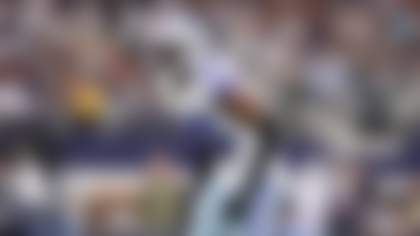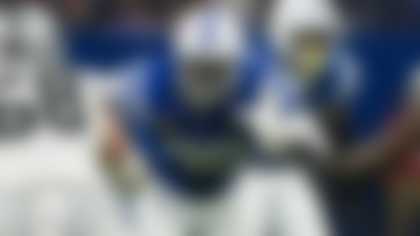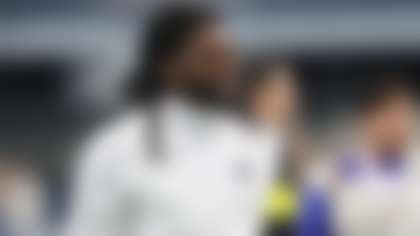This past year, Next Gen Stats revealed a new metric called completion probability. Instead of anecdotally wondering how difficult a throw and catch was on the field, we now have data to prove it.
Factoring in the distance the ball traveled, receiver separation, pressure on the passer, plus the quarterbacks' speed (i.e. how fast the QB is moving at release in MPH) and time to throw -- there is a lens to view how likely a pass is to be completed. So, which quarterback-receiver connections stood out last year? Let's turn to Next Gen's completion probability metrics to find out the league's most and least QB-WR tandems of 2018:
Most extraordinary QB-WR tandems
5. Kirk Cousins to Adam Thielen (10.2 percent catch rate above expectation)
Even though the Vikings offense cooled dramatically as the season progressed, Kirk Cousins and Adam Thielen undoubtedly formed one of the league's most efficient duo's. Thielen began the year with eight-straight 100-yard performances as Cousins trailed only Drew Brees and Matt Ryan in completion rate above expectation in this span. Curiously, Thielen's volume fell off of a cliff in the second half of the season. After opening the season with 12.0 targets per game in his first 8 contests, Thielen only managed to see 7.1 targets/game in the Vikes' final 8 games. In fact, Thielen saw double-digit looks just two more times after starting the year with 10-plus targets in 7-of-8 games. Minnesota's ultimate undoing was their horrendous offensive line, though. Cousins was under pressure on 50 percent of his third-down attempts last season, easily the highest rate in the NFL.
4. Deshaun Watson to DeAndre Hopkins (11.2 percent catch rate above expectation)
Shocker. Considering DeAndre Hopkins has dropped just one of his 234 targets from Deshaun Watson over the last two years, it should be no surprise this duo dominates catch probability metrics. Hopkins' overall catch rate (71 percent) was a ridiculous 15 points higher than his career average (56 percent) in 2018, leading to career-highs in both receptions (7.3) and yards (98.3) per game. Watson and Hopkins' chemistry is particularly impressive considering the way the Texans deploy their star receiver. Houston rarely moves Hopkins into the slot or in tight to their formation. Instead, they ask Nuk to run 85 percent of his snaps against boundary cornerbacks split out wide. As a result, Hopkins saw press coverage on 41.4 percent of his routes last season, the fourth-highest rate in the league. Despite rarely seeing easier draws against interior defenders, Hopkins routinely dominates at the catch point and he finally has a quarterback worthy of his talent. It's a perfect marriage.
3. Philip Rivers to Mike Williams (12.4 percent catch rate above expectation)
Perhaps the biggest surprise at the top this list, Mike Williams just had one of the most sizable second-year turnarounds in recent memory last season. After recording just 11 receptions in 10 games as a rookie, the former seventh overall pick went off for 43/664/10 in his sophomore campaign. Granted, having an MVP-caliber quarterback like Philip Rivers helps. Williams and Rivers' connection was particularly efficient in the intermediate part of the field (10-19 yards) where the duo completed 67 percent of their attempts (sixth-best) and formed a pristine 143.6 passer rating (second-best). Williams will be hard-pressed to score 10 TDs on just 66 targets again, but he's unquestionably going to be one of fantasy's premier full-blown breakout candidates in 2019. Tyrell Williams' likely departure in free agency will leave behind 63 total targets (13 percent share) and 21 percent of Chargers' air yards.
2. Drew Brees to Michael Thomas (16.1 percent catch rate above expectation)
Further solidifying Drew Brees as the most accurate passer of all-time, Michael Thomas' 85 percent catch rate in 2018 set a new single-season NFL record (minimum 50 targets). In fact, since the NFL began tracking targets in 1992, Brees' receivers have recorded 6 of the 30 best individual seasons in catch rate. That's ludicrous. Brees and Thomas earned a combined 126.3 passer rating on tight window throws (less than one yard of separation) last season, trailing only Russell Wilson and Tyler Lockett (146.8 rating - tight window) for the NFL's top spot. Even at 40-years-old, Brees' powers are stronger than ever.
Most extraordinary tandem: Russell Wilson to Tyler Lockett (20.1 percent catch rate above expectation)
Every statistic from Tyler Lockett's 2018 campaign is mind-blowing, but none are more impressive than his absurd 20.1 percent catch rate above expectation. As I noted in my Ten Observations from the 2018 fantasy season, what makes Lockett and Wilson's connection so special is where they earned their production. Consider this: Wilson and Lockett combined to complete 18-of-23 passes for 663 yards and seven touchdowns on passes that traveled over 20 yards in the air in 2018. All of those figures led the NFL. Even though Michael Thomas reset the record book for the league's best catch rate ever, Lockett's season was more impressive once you consider how deep he saw his targets downfield. Whereas Thomas' passing looks traveled 7.7 yards in the air on average (83rd-of-121), Lockett's 13.5 average depth of target was 15th-highest among all players. Even though the Seahawks laughably led the NFL by a mile in rush rate (56 percent), Wilson and Lockett found a way to make the most out of every play. Don't let Seattle's stone-age scheme deter you from considering Wilson-to-Lockett one of the NFL's premier tandems.
Honorable mentions: 10. Matthew Stafford-Kenny Golladay (6.3 percent catch rate above expectation); 9. Dak Prescott-Amari Cooper (8.3 percent); 8. Russell Wilson-Doug Baldwin (8.8 percent); 7. Matt Ryan-Julio Jones (9.2 percent); 6. Jameis Winston-Mike Evans (9.5 percent)
Least extraordinary QB-WR tandems
5. Josh Allen to Zay Jones (6.9 percent catch rate below expectation)
As the league's most aggressive deep ball thrower in 2018, it should come as no surprise that Josh Allen was on the wrong side of Next Gen's completion probability metrics. Granted, some of Allen's long-standing accuracy issues that stem back to college surfaced last year and may never be properly ironed out, but the Bills offensive scheme forced lower probability throws by design. Last year, no quarterback threw deep more often than Josh Allen (18.1 percent of throws traveled 20-plus yards in the air) while only Russell Wilson (23.7 percent) and Lamar Jackson (21.8 percent) threw on the run more often than Allen (21.6 percent).
Despite the Bills lackluster receiver corps, Buffalo asked Allen to hold the ball longer than 2.5 seconds on 68 percent of his pass attempts, second-most behind only Jared Goff (75 percent) and the most play-action heavy team in the NFL (35 percent; per PFF). By design, play-action demands the quarterback to hold the ball longer and the Bills used a fair amount with Allen, too (25 percent; tenth-most). However, Allen's receivers compounded the problem by dropping six percent of his passes -- tied with the Browns and Ravens receiver corps for the sixth-highest clip. Zay Jones' three drops alone didn't even come close to the worst offenders on the team. Behind a shoddy offensive line to boot, Buffalo must design some higher percentage throws and fill out their receiver depth chart in 2019 to help foster Allen's growth. For what it is worth, this is all coming from a once Allen pessimist. There was more than enough good from Allen's rookie year to work with -- particularly as a rushing weapon and on some deep connections to former-Bama speedster Robert Foster.
4. Baker Mayfield to Jarvis Landry (8.5 percent catch rate below expectation)
Cleveland's 2018 season can be clearly demarcated by two even samples: With and without Hue Jackson/Todd Haley. After GM John Dorsey canned Jackson/Haley after eight games, the Browns offense became significantly less reliant on Jarvis Landry in their final eight bouts. For reference, with Todd Haley as the offensive coordinator in Weeks 1-8, Jarvis Landry saw 11.8 targets per game and compiled double-digit passing looks in 7-of-8 contests. Once Freddie Kitchens took over (Weeks 9-17), the offense flipped tendency: Landry averaged just 6.8 targets per game and saw double-digit looks in 0-of-8 contests. The lowered pass volume and change in scheme helped both Landry and Mayfield's connection. Per Next Gen Stats, Landry's catch rate was 12 percent below expectation in Weeks 1-8 versus 6.2 percent below expectation in Weeks 9-17 with Kitchens calling the shots. Granted, neither figure is ideal considering the Browns just made Landry the fifth-highest paid in the league (in total guaranteed money). Regardless, the Browns must find a way to make the Mayfield-Landry connection far more efficient in 2019, especially considering Landry runs 70 percent of his routes from the slot. Those throws should be far more efficient for Mayfield.
3. Aaron Rodgers to Marquez Valdes-Scantling (9.3 percent catch rate below expectation)
Outside of Davante Adams, the Packers' receiver corps was one of the league's most disappointing groups in 2018. Randall Cobb battled through injuries once again, Jimmy Graham saw a career-low eight red-zone targets at 32-years-old, and none of their rookie wideouts stepped up consistently. 'MVS' certainly flashed at times last season, but his connection with Aaron Rodgers must improve if the Packers intend to count on him as a full-time player in 2019. Whereas just 14 percent of Adams' targets were in a tight window (less than one yard of separation), almost 25 percent of MVS' passing looks were at less than one yard of separation. Looking forward, I have zero expectations for Matt LaFleur in 2019 except that Aaron Rodgers must have signed off on him and the Titans were unlucky last season with a tough schedule and injuries to Marcus Mariota, Delanie Walker, and Jack Conklin. And he's not Mike McCarthy.
2. Blake Bortles to Keelan Cole (10.2 percent catch rate below expectation)
Owning the league's sixth-worst success rate when throwing into a tight window and fifth-worst success rate when throwing beyond 10 yards of the line of scrimmage, it should be no surprise that Bortles was among the least extraordinary signal-callers in 2018. Granted, Keelan Cole led the Jags' in drops (per PFF) despite being third on the team in targets, the main source of the problem in Jacksonville has been clear for some time. Since 2016, Bortles is dead last in completion rate below expectation (-3.5 percent) among qualified quarterbacks. The next worst QB in this span is Eli Manning (-2.3 completion rate below expectation). The Blake Bortles era ended with a whimper in 2018.
Least extraordinary tandem: Sam Darnold to Quincy Enunwa (12.2 percent catch rate below expectation) and Jermaine Kearse (13.3 percent)
Wielding the NFL's second-most cap space ($102.5M), the Jets need to devote their entire 2019 offseason to finding Sam Darnold some help. Granted, we're only working with a tiny sample of targets for both Jermaine Kearse (59) and Quincy Enunwa (50), but neither wideout helped their rookie signal-caller last season. Per Next Gen, Darnold's receivers only got open (3-plus yards of separation at pass arrival) on 37.7 percent of his attempts, the third-worst rate in the league. Further compounding the Jets' aerial issues, Sam Darnold was forced to hold onto the ball 2.91 seconds on average (sixth-highest rate) because their offensive line allowed pressure on 33 percent of Darnold's snaps from 11-personnel, the fifth-highest rate in the NFL. Receivers not earning separation on their own (or not being schemed into separation) compounded by sub-par protection is a sure-fire way to set your rookie quarterback up to fail.
-- Graham Barfield is the managing editor of fantasy football content at NFL.com. Follow him on Twitter @GrahamBarfield.




